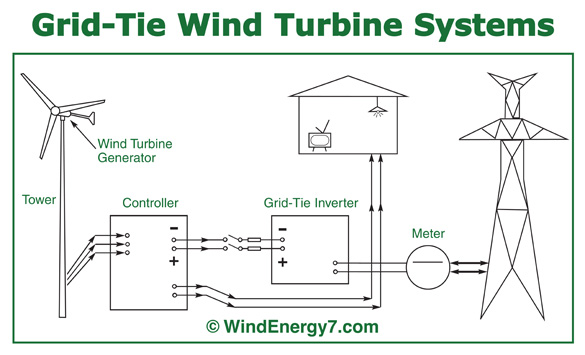


Inside the WTG, the generated torque forces a magnet and an electrical coil to interact, which (in accordance with Faraday’s law of electromagnetic induction) produces AC voltage: the type of electricity we require to power our homes. Finally, the gearbox feeds its mechanical energy into the wind turbine generator. This driveshaft is connected to a gearbox, which – through an increasingly smaller set of gears – dramatically increasing the torque generated by the turbine (in other words, a few RPM can be ramped up to hundreds or thousands of RPM). To be more specific, once wind begins rotating the blades of the turbine, the rotating blades turn a driveshaft inside the body of the turbine. In short, wind turbine generators take the slow kinetic energy produced as wind forces turbine blades to turn, and converts this energy into electrical charge, or voltage, which can then be used to power our homes and the electrical grid. That’s where wind turbine generators (WTGs) come in. However, wind power itself is not strong enough to generate electricity without some further help. In these circumstances, the kinetic (or mechanical) power of the wind is utilised in its mechanical form, and as the blades of the turbine turn, so too does the machinery it’s attached to. Wind turbines have been in use long before the discovery of electricity, when the power of the wind was used to pump water and turn grinding wheels in mills (hence the term ‘windmills’). Manufacturers and installers can provide you with a system package that includes all the parts you need for your particular application.Before we get stuck into the rest of the market, we should first explain how wind turbine generators work. The balance-of-system parts required will also depend on whether your system is grid-connected, stand-alone, or hybrid. For example, the parts required for a water pumping system will be much different from what you need for a residential application. The balance-of-system parts you'll need for a small wind electric system - those in addition to the wind turbine and the tower - will depend on your application. Tilt-down towers can also be lowered to the ground during hazardous weather such as hurricanes. While tilt-down towers are more expensive, they offer an easy way to perform maintenance. There are also tilt-down versions of each tower type. There are two basic types of towers: self-supporting (free-standing) and guyed (supported with wires). Most turbine manufacturers provide wind energy system packages that include towers. In general, the higher the tower, the more power the wind system can produce. Towersīecause wind speeds increase with height, a small wind turbine is mounted on a tower. The tail keeps the turbine facing into the wind. The diameter of the rotor defines its "swept area," or the quantity of wind intercepted by the turbine. The amount of energy a turbine will produce is determined primarily by the diameter of its rotor. The turbine's frame is the structure onto which the rotor, generator, and tail are attached. These blades are usually made of a composite material, such as fiberglass. Most small wind turbines manufactured today are horizontal-axis, upwind machines that have two or three blades. In addition to the turbine and tower, small wind electric systems also require balance-of-system components.

Small Wind Electric System ComponentsĪ wind electric system is made up of a wind turbine mounted on a tower to provide better access to stronger winds. This makes small wind electric systems a good choice for rural areas that are not already connected to the electric grid. Our wind power animation has more information about how wind systems work and the benefits they provide.Ī small wind system can be connected to the electric grid through your power provider or it can stand alone (off-grid). When the wind spins the wind turbine's blades, a rotor captures the kinetic energy of the wind and converts it into rotary motion to drive the generator. Wind turbines convert the kinetic energy in wind into clean electricity. Wind is created by the unequal heating of Earth's surface by the sun. Our pages on planning for a small wind electric system, and on installing and maintaining a small wind electric system have more information. Small wind electric systems can also be used for a variety of other applications, including water pumping on farms and ranches. Help uninterruptible power supplies ride through extended utility outages.Help you avoid the high costs of having utility power lines extended to a remote location.Lower your electricity bills by 50%–90%.If you have enough wind resource in your area and the situation is right, small wind electric systems are one of the most cost-effective home-based renewable energy systems - with zero emissions and pollution.


 0 kommentar(er)
0 kommentar(er)
